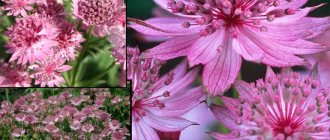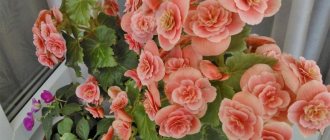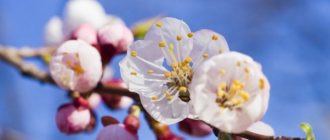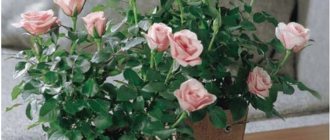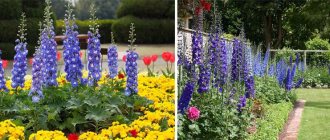- February 18, 2019
- Flowers
- Anastasia Efremenkova
Muscari has several names. This plant is also called viper's onion and mouse hyacinth. Muscari belongs to the genus of perennial bulbous plants and is included in the Asparagus family, but it came here recently, and was previously part of the Hyacinth family. Currently, there are about 60 varieties of viper onions. In nature, they can be found among shrubs; they are also found on forest edges and even on mountain slopes. As for the regions, muscari is a resident of Southern and Central Europe, Asia Minor, Crimea, the Mediterranean, and the Caucasus. This is a spring primrose that is one of the first to emerge from under the snow; it is the one that appears in flower shops on the eve of March 8th.
During flowering, this plant emits a very pleasant and persistent aroma that is simply impossible to pass by. If you want to grow it in your garden, then it is better to use the flower as a border plant. And then we will look at the features of planting and caring for muscari in the open ground; muscari, varieties of flowers and much more will also be presented in the photo.
General information
The root system of muscari is presented in the form of ovoid bulbs, which are covered with light outer scales. Their length is 1.5-3.5 centimeters, and their diameter can reach two centimeters. Basal linear leaves can reach a height of 17 centimeters. Usually their number does not exceed six pieces. They mainly appear with the onset of spring, but in some cases they can grow again in the autumn. The plant itself reaches a height of thirty centimeters. Below is a photo of muscari flowers.
It is distinguished by a leafless peduncle on which cylindrical, tubular or barrel-shaped perianths are located. They consist of several fused petals that are bent towards the edge. The flowers are distinguished by white or dark blue shades, are not very long, and reach only 0.5 centimeters. All flowers are collected together in apical or racemose inflorescences that grow no more than eight centimeters in length.
Muscari has a fruit presented in the form of a three-lobed winged capsule, which is shaped like a heart or a ball. Inside this box are collected black seeds. They retain their germination capacity for only one year. Two main advantages of this genus should be noted: muscari (photos are in the review) are not among the fastidious plants, and almost all types of plants are decorative.
Before you begin to study the features of growing muscari, you should find out its types and varieties, as well as their characteristics.
Botanical description of the flower
A bulbous perennial with simple basal leaves collected in a rosette. The bulbs are small, up to 2 cm in diameter and up to 3 cm long, and do not have noticeable imbricated scales. The leaves are narrow, linear or linear-lanceolate, 2-5 (up to 10) mm wide. The width is more or less the same along the entire length. The veins are clearly visible from below. The upper part of the leaf often dries out and breaks off. The height of the flowering plant can reach 20 cm. The length of the leaves often exceeds the length of the peduncles.
Peduncles erect, leafless. Inflorescences are racemose, dense, narrow pyramidal or ovoid . The lower flowers are fertile, blue or blue in color with a light border, goblet-shaped, cylindrical or tubular in shape, 3.5-5.5 mm long, 0.4 mm wide. Pedicels are short, drooping.
The upper flowers are sterile, painted in a lighter shade. Although uniform coloring of all flowers is possible. Flowering occurs in the second half of April - the first half of May. The average flowering time is 3 weeks.
The fruit is a winged three-lobed capsule, spherical or heart-shaped . Some varieties do not produce seed pods. The seeds are small, wrinkled, black.
Muscari Armenian
This species is most common due to its winter hardiness. It has another name - Colchian. Colchian muscari begins to bloom at the end of spring and this process lasts no more than three weeks. The name “mouse hyacinth” (photo below) is applicable specifically to this species. It has unusual inflorescences, the upper flowers of which can be safely called sterile, since they are lighter than the flowers located below, which have a dark blue tint and a white border. This muscari has a very pleasant aroma, which is impossible not to notice when being next to a flowering plant.
Medicinal properties
Muscari petals have beneficial properties - they contain esters, flavonoids, organic acids, and ascorbic acid.
The plant is used as a wound-healing, bactericidal and aphrodisiac. Traditional medicine in Asian countries uses essential oil to treat bronchitis, massage, aromatherapy, colds, and insomnia.
The perfume industry also did not ignore this fragrant flower; its notes create the aroma of perfumes and are used in cosmetology.
At home, bouquets of mouse hyacinths are placed not only for beauty: the plant repels flies, mosquitoes, and midges. Cannot be used internally, the plant is poisonous.
Muscari crested
A very original plant that will decorate any garden or flower bed. If you want to find this species in natural conditions, then go searching in dry forest edges or meadows. The peduncle of this plant resembles a fluffy purple tuft. The peduncle has the shape of an arc. To decorate your site in a truly original way, plant crested muscari on lawns and lawns where ground cover grasses are grown.
This is not a complete list of types and varieties of muscari with photos that exist today, but the types described above are the most popular and unpretentious.
Distribution area of armeniacum (armenicum)
The natural distribution area of Armenian muscari covers the northwestern part of Turkey, southwestern Transcaucasia, Greece, the eastern Mediterranean, the Caucasus, including Armenia, which gave the specific name to the plant.
However, the plant has expanded far beyond its natural range. Grows in meadows and forests.
Armenian muscari is one of the most popular species, which has been grown in European gardens since the mid-19th century . Thanks to frost resistance, unpretentiousness, high decorativeness and early long flowering, this species has won the love of gardeners around the world.
Features of cultivation
It should be noted that various types of muscari (see photo in the article) are very popular among experienced and novice gardeners. They can be grown not only near borders, but also in rock gardens, multi-tiered flower beds, and they can be combined with various spring flowers, creating wonderful compositions in your garden. Daffodils and tulips look good against the background of muscari; the main thing is to choose the right color scheme. You can also plant muscari near orange hazel grouse. This composition will be very bright and attractive to the eye.
Muscari are not much different from other early flowering spring plants. The first flowers appear on them even at a time when buds are just beginning to appear on the trees, and leaves are not worth even dreaming about. Based on this, we can conclude that these flowers can be planted anywhere, since nothing will prevent them from receiving a sufficient amount of sunlight.
At the beginning of the article it was said that muscari is a perennial plant, so it grows in one place for more than one year. Based on this, you should not plant a flower next to those flowers that need annual replanting. As for the soil, it is better to choose loose and fertile soil with good water permeability. Also try to choose a site that will be located on a small hill, which is necessary so that water does not stagnate in the roots and strong wind does not blow on the flowers.
Types and varieties of muscari with photos
Armenian Muscari (Muscari armeniacum)
The winter-hardy Armenian (Colchian) muscari is very popular among gardeners. Its flowering begins at the end of spring and lasts about 20 days. This species is called “mouse hyacinth”. The flowers located in the upper part of the inflorescences are sterile, and they are colored light blue. The dark blue flowers, located in the lower part of the peduncle, have a white border. The flowers have a pleasant smell.
The most popular varieties:
- Muscari terry Blue Spike . It is very decorative due to the fact that the cluster-shaped inflorescence includes up to 170 flowers. It is unpretentious and is often used for cutting.
- Christmas Pearl . It has very decorative purple flowers.
- Fantasy Creation . A very impressive variety due to the combination of greenish-blue and blue flowers.
Muscari botryoides
Under natural conditions, this species can be found in the alpine belt of Central and Southern Europe. It has been considered the most popular among gardeners since 1576. The flowers of this species are somewhat smaller compared to Armenian muscari. Almost all varieties are colored in various shades of blue, but there are 2 varieties:
- V album . The cluster-shaped inflorescences consist of white flowers similar to pearls.
- V carneum . The flowers are pink in color.
Muscari latifolia
The leaf blades of this species are very wide and similar to the foliage of a tulip. The inflorescences are dense, cylindrical in shape and dark blue in color. It stands out among other species in that several flower stalks can grow from one bulb at once.
Pale muscari (Muscari pallens)
In natural conditions it can be found on mountain slopes. The peduncles are low, and small bell-shaped flowers of a light blue color appear on them. The most popular variety is White Rose Beauty: the color of its flowers is light pink.
Muscari crested (Muscari comosum)
Very impressive look. In the wild, it prefers to grow among bushes, on the edges of forests, and also in dry meadows. On the peduncle there is a pappus, consisting of purple flowers with arched peduncles. This species looks very impressive on lawns or lawns against the background of ground cover grass. The most popular variety is Plumozum: the shoots are highly branched, and they have a large number of sterile flowers of violet-lilac color.
Muscari Oshe, or Tubergen
It can be found in nature in Northwestern Iran. Flowering occurs in mid-spring. Blue flowers have lighter colored teeth. Good drainage is necessary. The most popular variety among gardeners is Tubergen, which has paler flowers and crescent-shaped leaf blades.
Pretty Muscari (Muscari pulchellum)
This species has a Hebrew name that sounds like kadan nae (beautiful). You can see such flowers in the parks of Ashkelon. They begin to bloom in winter. The peduncles are low, and on them there are dense, short, ovoid inflorescences with a deep blue color. The teeth of the bend are painted white.
In addition to these species, the following are also very popular among gardeners: muscari long-flowered, changeable, ambrosia, white-fruited, large-fruited, strange, multi-flowered, densely flowered, racemose, etc.
Disembarkation time
Muscari should be planted in the fall, no later than the end of October. Disembarkation is carried out in groups. If you are replanting existing plants, it is recommended to replant no more than once every five years. As for the purchased bulbs, they need to be carefully inspected when purchasing, and also pay attention to the shoots: they must have a healthy appearance; rot or other damage must not be present. If you didn’t have time in the fall, then try to buy muscari bushes in April that are already blooming. This method of landing also has a good chance of success.
Description of muscari: varieties from which varieties come
Cute blue bells with a white skirt, the unusualness of which attracts, giving rise to the desire to plant a couple more varieties... Do you have the same picture? This means that this means Armenian muscari (lat. Muscari), or mouse/grape hyacinth, or viper onion - a flower that belongs to the asparagus family. Initially, it was classified as a member of the Liliaceae family, but later, upon closer study, the breeders realized that they were mistaken. The flower's habitat is Southern Europe, the Mediterranean, the Caucasus, Asia Minor, Crimea. In total, there are more than 60 types of muscari, the most popular of which are:
- Muscari Tubergen (Oshe), characterized by short stature and sickle-shaped leaves. A striking feature is the early flowering period;
Muscari Tubergen (Oshe)
- pale muscari, a regular on the Crimean peninsula. Particularly loved by flower growers for their resistance to bad weather and the rich hue of their bells;
- crested muscari, which is distinguished from others by flowers on arched pedicels. They decorate lawns and driveways, using them as a ground cover;
Muscari crested
- muscari is cluster-shaped, distinguished by small flowers. A bright “trick” - in 2 varieties of white and pink shades;
- Armenian muscari, the most common among flower growers and breeders. Everyone will like the bush’s power, resistance to diseases, fairly large flowers and a large number of varieties, each of which is special.
Muscari Armenian
Attention! There are more than 170 varieties of Armenian muscari. There are plants with white, lilac, violet, blue and pink flowers to choose from. A striking advantage is the huge number of flower stalks on the bush.
Landing technology
Before planting plant bulbs in the ground, inspect them thoroughly to make sure they are free of diseases and damage. If there are damaged areas, they should be removed immediately.
For the purpose of prevention, the bulbs should be disinfected. First, they are placed in a two percent solution of karbofos for thirty minutes, after which they are placed in a one percent solution of potassium permanganate for the same period of time.
You need to prepare for planting bulbs in advance. To do this, the day before planting, you need to water the prepared holes well. Moistening should take place so that the entire soil layer is wet. It is recommended to use river sand as a drainage layer.
Large bulbs are deepened by seven centimeters with a distance between them of 5-10 centimeters. As for the smaller ones, they are placed at a distance of 2-3 centimeters from each other, and deepened only three centimeters into the soil.
Features of forcing mouse hyacinth
The bulbs are dug up after the leaves have fallen, they are washed and sprayed with Fitosporin. The largest bulbs with a diameter of 6-10 cm should be selected.
We need to check that they are healthy. The bulbs need to be dried a little at room temperature and placed in a well-ventilated and dry place (t=+20°C) until September.
You need to time your bulbs exactly according to when you want the plants to bloom.
Attention! They require 3-4 months of aging at low temperatures, and another 2-3 weeks for forcing.
First, place the bulbs in dry sawdust, cotton wool or wrap them in paper, and place them in a room with +9°C for 35 days. And then lower the temperature to +5°C, for this you can put them (onions wrapped in paper) in the refrigerator.
Afterwards, mouse hyacinth is planted in moistened soil in pots, the bulbs are buried 2 cm so that their top remains exposed to the air, and the pots with plants are placed in a cold place (t=+5°C) for 2 weeks. The soil is made by mixing forest soil, peat soil, sand or perlite. Pre-broken brick and expanded clay are poured onto the bottom of the pot.
Next, the pots are placed indoors (t=+10°), then after 1-3 days the temperature is increased to +15°C. If the soil dries out, then water it, but so as not to get on the bulb. And after another week, make the air temperature about +25°C, otherwise the crop will not bloom.
The inflorescences of the viper onion bloom within 10 days. And this video talks about how to plant viper onions in a flowerbed in the fall:
Features of garden care
There should not be any difficulties when caring for muscari in the garden. This applies to both experienced and novice gardeners. In general, this flower can be safely called a training flower, since due to its unpretentiousness it is perfect for beginners. Muscari needs to be watered only when it enters its growing season, but often this period passes while the soil is still moist, after rains and melting snow. Therefore, you won’t have to water the flowers particularly often. During the muscari dormant period there will be quite enough rain. Regular watering will be required only if there was no snow in the winter and the spring was dry.
How to grow in a container
The bulbs are planted in a plastic pot in the fall. If you plant not in a container, but directly in the soil, then when removed from the ground, you can destroy the plants by damaging their delicate roots. Be sure to first make holes in the pot for drainage, then drop it in the area.
In the spring, mouse hyacinths are transferred with a lump of earth from a pot into a cache-pot (its difference from a pot is that it has no drainage holes, and it can also be hung, as a result the plants in the apartment look very decorative).
When viper onions bloom in flowerpots, they are watered and fertilized more often than muscari growing in the garden. After the plants have flowered, they are again transplanted into a pot and buried in the ground, leaving them for the winter.
What kind of soil is needed
Pay attention to the soil. If your site is not particularly fertile, you will need to fertilize it with organic fertilizers. Compost or humus is perfect for this. It is recommended to carry out such fertilizing in the fall, during digging. Please note that for every square meter you will need about five kilograms of fertilizer. If such fertilizing and digging are carried out regularly, then muscari will be able to grow in one place for about ten years and still feel great. However, over time you will still have to undergo a transplant.
Bloom
As already mentioned, muscari blooms for approximately three weeks, in some cases perhaps a little longer. No special care for the plant is required during this period. The main thing is to loosen the soil a little immediately after moistening the soil. When weeding, you need to be as careful as possible so as not to damage the bulbs. You should also remove weeds from the beds and remove inflorescences that have already faded. They not only spoil the aesthetic appearance of your flowerbed, but also prevent the plant from developing and blooming normally. Monitor the quality of the flowers; if it deteriorates, you should immediately replant the plants.
The use of plants in landscape design
Plants are a wonderful addition to the spring garden.
- To maintain a flowering area, other late-blooming plants can be added to the nutmegs.
- They look great in combination with clay garden figurines.
- They are often planted as hedges along paths and paths. A beautifully flowering border will be an elegant and discreet addition to your landscape design.
- In addition to growing muskmelon in the garden, these plants are also grown indoors as potted flowers.
Transfer rules
Dividing the mother bulb is a vegetative method of propagation. This transplantation is carried out in the fall, starting from mid-October until the end of the month. This procedure is carried out no more often than once every five to six years, provided that the plant was in one place for this period of time. However, you yourself will understand when to transplant. The flowerbed itself will “tell” you about it.
To transplant the bulbs, you should remove them from the ground and separate the children from them. Their number can exceed 30 pieces. As for the landing method, it was described above.
Use of muscari flowers for decorative purposes
Muscari is an ideal plant for creating mini-flower beds for the garden, fenced with low fences, birch branches or decorative pots. Blue muscari perfectly serve as a fence along garden paths or serve as an unusual border along paths. They can be used as a separate array, or planted under trees or shrubs, to create original compositions together with other flowers.
Muscari goes well with many colors and can be used to create original compositions.
Muscari forcing is also used for decorative purposes - artificially stimulating the flowering process in the off-season. For this, the largest bulbs are selected. They are dug up in July at a temperature of 15 degrees, dried and stored until the beginning of September. In the period from September to January, rooting of the bulbs is done. To do this, pour drainage into the bottom of the pot and plant the plant in a nutritious soil mixture consisting of sawdust, humus, leaf soil and a small amount of sand.
For the winter, plants are placed in a basement or greenhouse insulated with sawdust. In January, during the germination of sprouts, the flowers are moved for a couple of days to a room where the temperature remains no higher than 5-8 degrees. The second stage of movement is forcing at a temperature of 15-18 degrees. At this time, watering is carried out moderately, using warm soft water. This helps speed up the flowering process.
How to use flowers in the design of a summer cottage
There are several options for using muscari to decorate a summer cottage. The picturesque trio of blue muscari, forget-me-nots and white tulips looks beautiful. The plant can be planted in a small bucket and displayed in a flowerbed composition.
Muscari looks good in a flowerbed composition.
Next to blue flowers, for example, orange imperial hazel grouse will look beautiful. Planting under bare shrubs, such as Arabis or Iberica, will help create the most comfortable conditions for flowers. They also fill the empty spaces formed between tulips and daffodils.
Reproduction
The vegetative method of propagation is not the only one for muscari. These plants also reproduce well by seeds, by self-sowing. But if you do not want the flowers to spread randomly throughout the flowerbed, then all faded flower stalks should be removed immediately. You can leave only a few of them to collect seeds from them later. As mentioned earlier, ripened and collected seeds can germinate only within one year. They should be deepened no more than 1-2 centimeters. The shoots look like thin strings that inform the gardener that the formation of bulbs has begun. Flowering should be expected no earlier than three years after planting.
Landing
To enjoy the low, expansive carpets filled with delicate, bell-shaped muscari flowers, you need to know a few secrets about them. They are not demanding plants and basic knowledge is enough to cope with planting and growing muscari.
Selection and storage of bulbs
Muscari are bulbous plants. Their bulbs are quite small - usually up to 8-10 cm in diameter. They reproduce well and quickly, forming numerous baby bulbs, with which you can create new muscari plantings. The bulbs chosen for planting must be of high quality; signs of a good bulb:
- the outer coating is not over-dried;
- the shell is not too wet;
- no damage (small cuts can lead to the spread of fungal disease).
Many manufacturers sell muscari bulbs treated with an appropriate drug that protects them from diseases and pests. It's worth finding out in advance. Then there is no need to process them during storage. Bulbs are stored in a cool, dry place. They can be placed in a box with sand or sawdust.
When to plant?
Muscari can be planted in spring and autumn. This plant is very frost-resistant and copes well with snow. Therefore, it is better to plant muscari in the fall - a few weeks before frost. The plant will take root and last all winter, even without shelter. Autumn planting is a guarantee that muscari will appear in the spring, and their flowers will become a wonderful decoration in the spring garden.
The best time to plant muscari is from mid-September to mid-October. Bulbs in a pot can be planted all spring and even winter.
Muscari can grow quite densely nearby. The ideal distance is 7 × 10 cm.
Soil requirements
To plant muscari, you need to choose a sunny or slightly shaded place. The soil for muscari should be:
- well drained;
- moderately fertile;
- without undecomposed organic fertilizers;
- permeable;
- constantly moist during the growing season, but not over-moistened, without stagnant water - excess moisture can lead to rotting of the bulbs;
- The soil pH is close to neutral or slightly alkaline (pH 6-7).
In the flooded area, you need to ensure good drainage and bring the soil to the best conditions for the plant:
- If the soil is heavy and clayey, you need to add compost and sand.
- If the soil is too sandy, it should be supplemented with humus, compost or peat.
Places where snow is thrown when cleaning the yard in winter, and where snow falls from the roof, are not suitable for planting muscari.
Landing in the ground
Plant muscari flowers in a place where the spring sun will shine for at least several hours a day.
The correct planting depth is very important - equal to three times the height of the bulb. If you make a mistake with the depth, it will cause problems:
- if you plant muscari too shallowly, they will freeze in the cold;
- if planted too deep they will struggle to reach the surface and after a few years the bulbs will shrink.
How to plant muscari in open ground - step by step:
- The area needs to be dug up.
- We choose all the weeds.
- Before planting muscari, we add organic matter to the soil (10-liter bucket of well-rotted compost per 1 square meter of flower bed).
- If necessary, we enrich the holes with a drainage layer and, possibly, an admixture of sand. You can also pour 1-2 handfuls of compost into each hole - under each bulb.
- We plant muscari bulbs at a depth of approximately 5-6 cm. For aesthetic reasons, it is recommended to plant at least 10 bulbs - these flowers look good in group plantings.
- After placing the bulbs in the ground, cover them with a layer of soil, lightly press the soil, and water.
- We carry out mulching, using: bark, peat, compost, wood chips.
Muscari overwinter well and quickly reproduce by bulbs. In a few years they will double the number of bulbs. And in 10 years, a real spring sapphire carpet will grow.
Planting in pots at home
Growing muscari in a pot is a great idea. Their intense, interesting flowers brighten up any interior. They can be grown in a pot all year round, even in winter. A few weeks before the garden wakes up, the first spring flowers will already bloom on the windowsill. Flowering muscari in containers and decorative baskets can be purchased at a garden center. After flowering, they do not need to be thrown away; they can be successfully grown every year.
When to plant muscari in pots? About 6 weeks before you want to enjoy the unique flowers, you can start planting in pots.
Before planting muscari in a pot, their bulbs need to be cooled. It's a little trick of nature that involves chilling the bulbs for a period of time and then speeding them up. This procedure can be carried out at home - all you need is a windowsill and a refrigerator. The bulbs are placed in the refrigerator for several weeks, packed in a cloth bag. They must be protected from excess moisture.
The bulbs are kept in the refrigerator for 10-15 weeks. This is enough for them to receive the right dose of cold and initiate flowering. Only then are they suitable for planting in a pot.
After this time, the bulbs are planted in pots so that their upper part remains 1/3 open. Muscari are planted in containers filled with fresh, pre-fertilized soil. In pots, you need to pour a drainage layer on the bottom, for example, from small pebbles.
After planting, the pot should be placed on a sunny windowsill. There are no soil type or high temperature requirements. The bulbs will need a little water and a temperature of no more than 15 degrees. When we take the bulbs out of the refrigerator and expose them to the light, deceived, they will decide that spring has come and will begin to grow intensively. After a few weeks, the first flowers will appear from the thin leaves.
Muscari varieties from the Magic collection are perfect for planting in pots: three varieties of “Muscari Oshe” (Muscari aucheri) of different colors:
- white "White Magic" White Magic;
- blue "Blue Magic" Blue Magic;
- blue "Ocean Magic" Ocean Magic.
The advantage of these varieties is their short leaves, which do not obscure the beautiful flowers growing on long stems (up to 20 cm).
Diseases and pests
Various types and varieties of muscaria flowers (photo in the article) can also be attacked by pests and suffer from various ailments. Most often, muscari is bothered by mosaic, which is a consequence of the appearance of a virus such as onion yellow dwarf. The symptoms of mosaic cannot be ignored, since it appears in the form of a green mosaic on the leaves, the plant produces shortened flower stalks, the leaves become narrower, and the growth of the diseased specimen is greatly slowed down.
The plant can also become infected with the usual cucumber mosaic, which appears on the leaves in the form of pale green streaks and spots. The carrier of viruses is aphids; if the mosaic gets into the bulb, it will begin to develop there. That is why there can be no talk of any treatment. All damaged specimens are dug up and simply burned, since they cannot be cured.
In this case, it is necessary to fight aphids, the main carrier of the disease. But fighting these insects is quite simple. You will need to dilute two teaspoons of liquid soap in two glasses of water and spray the plants with this solution.
Muscari can also be attacked by spider mites. It should be combated with the help of various drugs that can be purchased in the store.
